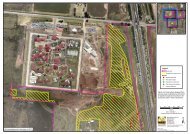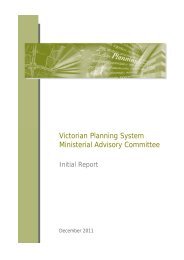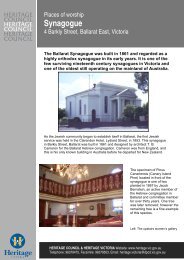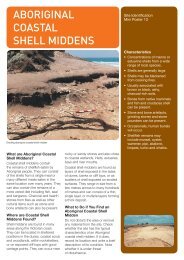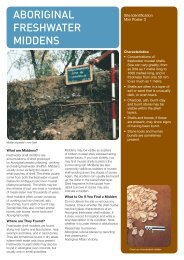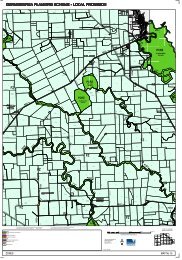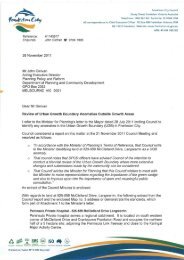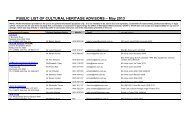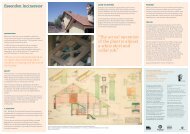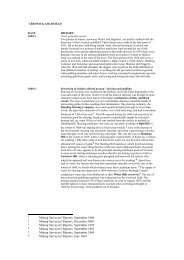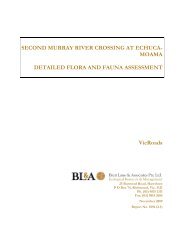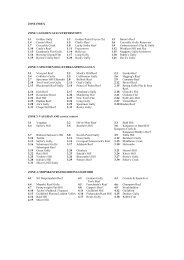Bendigo General History - Department of Planning and Community ...
Bendigo General History - Department of Planning and Community ...
Bendigo General History - Department of Planning and Community ...
You also want an ePaper? Increase the reach of your titles
YUMPU automatically turns print PDFs into web optimized ePapers that Google loves.
late 1850s: The issue that occupied the most attention in the post-Eureka period, far transcending local<br />
issues was the L<strong>and</strong> Question. The licence fee had been abolished; digger hunts were an ugly<br />
memory; the digger voice had found an echo in parliament <strong>and</strong> local government was groping<br />
its way into being. One major grievance persisted - the squatters iron grip on the l<strong>and</strong>. The<br />
grievance deepened as the digger’s world began to disappear. Occasional rushes flared to<br />
keep alight his hopes but as the years drifted into the late fifties, the digger, tired <strong>of</strong><br />
scratching a meagre living, mostly on dying fields, turned envious eyes to the squatters’<br />
holdings. The dream <strong>of</strong> returning home, fortune in h<strong>and</strong> had faded; for many, adventure had<br />
ceased to beckon. Most diggers had been in their early twenties on arrival; they were now<br />
nearly thirty. They thought <strong>of</strong> marriage, <strong>of</strong> settling down - but the l<strong>and</strong>s were locked against<br />
them ... 1<br />
late 1850s: But if the thoughts <strong>of</strong> many diggers in the late fifties <strong>and</strong> early sixties turned hungrily to the<br />
l<strong>and</strong>, there were others in the <strong>Bendigo</strong> Valley content with the glint <strong>of</strong> gold in the puddling<br />
tub, or convinced <strong>of</strong> the riches awaiting discovery in the great quartz reefs that buckled <strong>and</strong><br />
plunged deep below the valley. 2<br />
Whipstick nuggets<br />
Sept 1857: Br<strong>and</strong>y Gully2 nuggets, 194oz & 68oz by puddler named Pahlow. A reminder <strong>of</strong> Pahlow<br />
still exists in S<strong>and</strong>fly Gully. Enclosing an area <strong>of</strong> perhaps 1/4 acre, the remnants <strong>of</strong> an old<br />
stone wall <strong>and</strong> foundation <strong>of</strong> old chimney. Pahlow’s former home.<br />
Nov 1857: Elysian Flat. Greatest rush in the Whipstick was to Elysian Flat in Nov 1857. It was rich<br />
nugget country <strong>and</strong> from 1858 to 1904, 21 nuggets ranging from 22 to 240 oz were<br />
recovered. 16 <strong>of</strong> this number found during 1858, the boom year at Elysian Flat. 1857-58:<br />
Scotchman’s Gully: 7 nuggets <strong>of</strong> from 22 to 370ozs - the 370ozs (named Whipstick<br />
monster). 3<br />
Nov 1857: The Elysian Flat Diggings (now Neilborough) on the fringe <strong>of</strong> the Whipstick revived<br />
...[alluvial]...hopes. 4<br />
1857: Whipstick - A note in 1857 tells us that one <strong>of</strong> the chief openers <strong>of</strong> the Whipstick<br />
was a Mr Moorehead, who discovered S<strong>and</strong>fly Reef. Early that year Drunken Scotchman’s<br />
Gully, Paddy’s Gully <strong>and</strong> S<strong>and</strong>fly <strong>and</strong> Br<strong>and</strong>y Gullies were opened up ... The gullies northwest<br />
<strong>of</strong> Scotchman’s, near Flagstaff Hill, were discovered at this time, <strong>and</strong> in May 1857<br />
Phillips <strong>and</strong> party discovered gold about eight miles to the north-east at what became<br />
Phillip’s Gully, where 400 men were working in July. 5<br />
1857: <strong>Bendigo</strong> Advertiser 29 May 1857 - made Phillips Gully Rush public - new <strong>and</strong><br />
payable gold-field had been discovered by some parties working near the outskirts <strong>of</strong> the<br />
Whipstick Scrub, in the vicinity <strong>of</strong> Piccaninny Creek, about 28 miles from town. The<br />
greatest drawback to mining in the Whipstick had been the almost continual shortage <strong>of</strong><br />
water. At Phillips Gully, the diggers united in an effort to improve their supply. By mid-June<br />
it was possible for anyone to reach Phillips Gully without becoming lost. From the recentlyfinished<br />
road from Scotchman’s Gully to the northern plains, a rough track branched <strong>of</strong>f to<br />
the new rush ... At this rush the population was estimated at between 150 <strong>and</strong> 200. Three<br />
small stores <strong>and</strong> a butchers shop had been erected <strong>and</strong> the miners were busy building their<br />
new dam ... The gold in this gully was very fine, no nuggets were found <strong>and</strong> only a few were<br />
successful. For most it was a failure <strong>and</strong> the end <strong>of</strong> June spelled “Finish” to this rush. Seven<br />
years later, Phillips Gully was again the scene <strong>of</strong> a minor rush. In April 1864, some 50 miners<br />
were working here, but with unspectacular results. Today, Phillips Gully is deserted, but<br />
numerous eroded, shallow holes remain. Also there are remnants <strong>of</strong> several puddling<br />
machines, relics <strong>of</strong> those who worked in the gully later. 6<br />
July 1857: The Whipstick Prospecting Association. By July 1857, many prospectors <strong>and</strong> residents <strong>of</strong> the<br />
Whipstick realised the necessity for a combined effort to promote a more thorough search <strong>of</strong><br />
the scrub for mining purposes ... Little was heard concerning the Association until on 31<br />
1 Cusack, 1973, p112-113<br />
2 Cusack, 1973, p115<br />
3 Perry, 1975, pp166-176<br />
4 Cusack, 1973, p125<br />
5 Flett, 1979, pp246-47<br />
6 Perry, 1975, pp33-37



